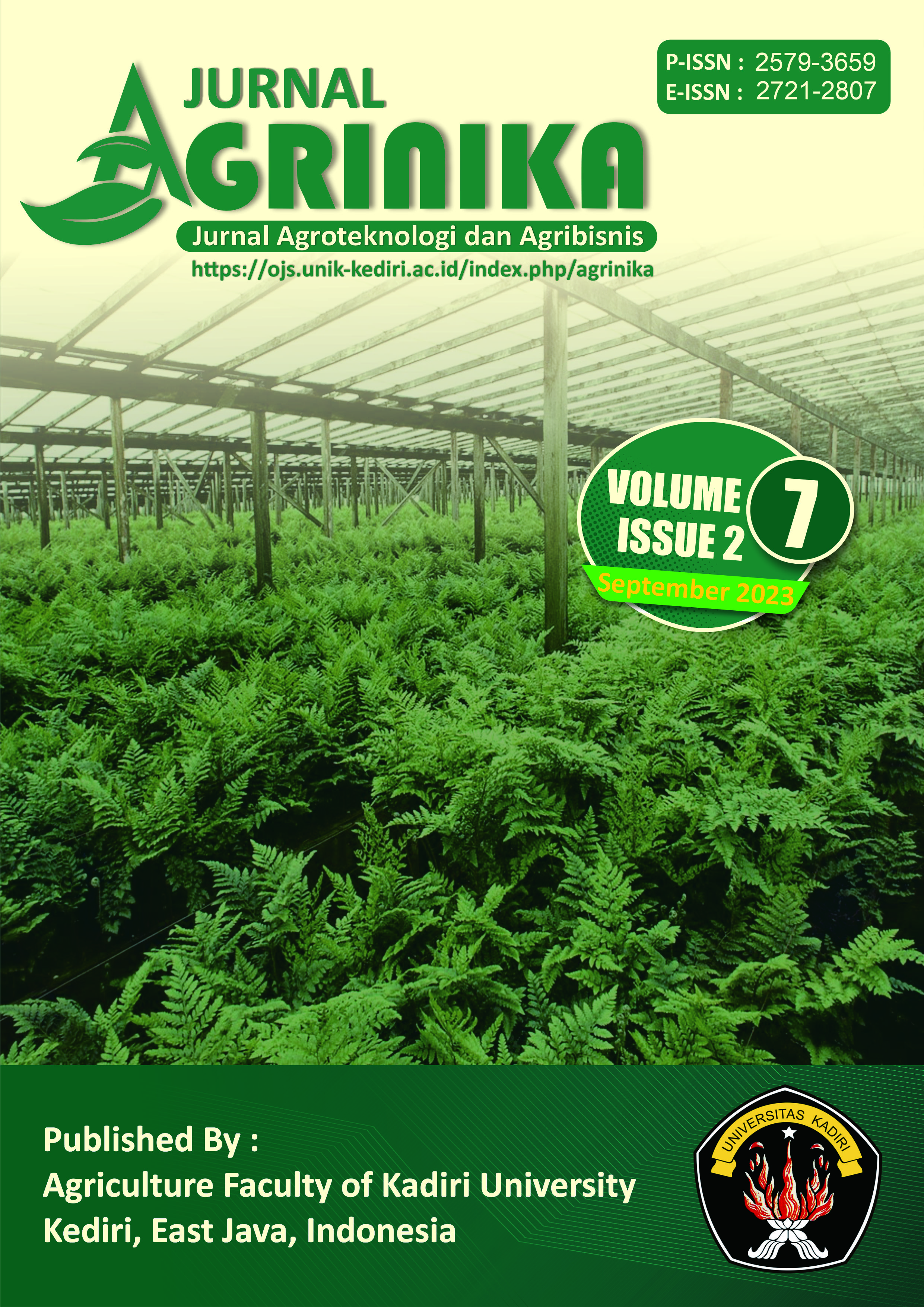Behavior of Shallot Farmers in Probolinggo Regency on The Use of Chemical Pesticides
DOI:
https://doi.org/10.30737/agrinika.v7i2.4693Keywords:
chemical pesticides, farmer behavior, shallotAbstract
This research was conducted based on the conditions for controlling shallot pests in Probolinggo Regency, which still uses chemical pesticides, far from sustainable agricultural practices. Therefore, this study aims as follows: 1. To identify the knowledge of shallot farmers on chemical pesticides; 2. Identify farmers' responses to pests and diseases of shallots; 3. Knowing the pattern of chemical pesticides used by farmers; 4. Develop academic plans on reducing the use of chemical pesticides. This research was a type of descriptive research; the research looked at the phenomena in the research location symbols in society that are considered essential. The approach used in the research was quantitative. In this study, observations were made first to see the initial conditions of the research location, then continued with direct observations of the research location area to collect data according to the results obtained from the intended respondents. The results showed that shallot farmers' knowledge level in Probolinggo Regency was still in the medium category. Meanwhile, the attitudes and actions of farmers in using chemical pesticides were included in the poor level.
References
Adriyani, R. (2006). Usaha Pengendalian Pencemaran Lingkungan. Jurnal Kesehatan Lingkungan, 3(7), 95–106.
Ameriana, M. (2008). Farmer’s Behavior in Using Chemical Pesticide on Vegetable. J. Hort., 18(1), 95–106.
BPS. (2020). Kabupaten Probolinggo Dalam Angka 2020 (Vol. 148).
Duriat, A. S., Soetiarso, T., & Prabaningrum, L. (1997). Penerapan Pengendalian Hama Penyakit Terpadu pada Bawang Merah. Puslitbang hortikultura.
Frost, M. (2001). Quality Criteria and Standards. Berlinickestr, Berlin, Germany, 113–121.
Gerungan, A. (2004). Psikologi Sosial. Rafika Aditama.
Moekasan, T.K, Setiawati, W, Hasan, F., Runa, R, dan Somantri, A. 2013. Penetapan ambang pengendalian Spodoptera exigua pada tanaman bawang merah menggunakan feromonoid seks. J. Hort. 23(1):80-90.
Moleong, L. J. (1994). Metode Penelitian Kualitatif. PT Remaja Rosdakarya.
Oluwole, O., & Robert, A. C. (2009). Health and Environmental Impacts of Pesticide Use Practices: a Case Study of Farmers in Ekiti State, Nigeria. International Journal of Agricultural Sustainability, 7(3), 153–163. https://doi.org/10.3763/ijas.2009.0431
Purwanto. (2005). Tujuan Pendidikan dan Hasil Belajar. Jurnal Teknodik Depdiknas.
Rambe, S. S. M., & Honorita, B. (2011). Perilaku Petani dalam Usahatani Padi di Lahan Rawa Lebak. Prosiding Seminar Nasional Budidaya Pertanian, 115–128.
Salameh, P. ., Baldi, I., Brochard, P., & Abi, S. B. (2004). Pesticides in Lebanon: A Knowledge, Attitude, and Practice Study. Environ Res. https://doi.org/10.1016/s0013-9351(03)00092-6
Schumacher, T. ., & Schreiber, R. D. (2015). Neoantigens in Cancer Immunotherapy. Science, 69–74. https://doi.org/10.1126/science.aaa4971
Sofia, D. (2001). Pengaruh Pestisida dalam Lingkungan Pertanian. 2–3.
Suharjono. (2011). Dampak Implementasi Sekolah Lapang Pengendalian Hama Terpadu (SLPHT) Padi Terhadap Penggunaan Pestisida. Agrovigor, 4(1), 28–33.
Sulistiyono, L., Tarumingkeng, R. C., & Sanim, B. (2008). Pengetahuan Sikap dan Tindakan Petani Bawang Merah dalam Penggunaan Pestisida. J. Agroland, 15(1), 12–17.
Setiana, L. (2005). Teknik Penyuluhan dan Pemberdayaan Masyarakat. Penerbit Andi.
Downloads
Published
Issue
Section
License
Copyright (c) 2023 Bintar Probo Sunarto, Mintarto Martosudiro, Luqman Qurota Aini, Yayuk Yuliati, Mokhtar Effendi

This work is licensed under a Creative Commons Attribution-NonCommercial-NoDerivatives 4.0 International License.
Authors who publish in this journal agree to the following terms:
- Authors retain copyright with the work simultaneously licensed under a Creative Commons Attribution License (https://creativecommons.org/licenses/by-nc-nd/4.0/) that allows others to share the work with an acknowledgement of the work's authorship and initial publication in this journal. Permitted third-party reuse is defined by the Creative Commons Attribution-NonCommercial-NoDerivs (CC BY-NC-ND). This permission allows users to copy and distribute the Article, provided this is not done for commercial purposes and further does not permit distribution of the Article if it is changed or edited in any way, and provided the user gives appropriate credit (with a link to the formal publication through the relevant DOI), provides a link to the license, and that the licensor is not represented as endorsing the use made of the work.
- Authors are able to enter into separate, additional contractual arrangements for the non-exclusive distribution of the journal's published version of the work (e.g., post it to an institutional repository or publish it in a book), with an acknowledgement of its initial publication in this journal.
- Authors are permitted and encouraged to post their work online (e.g., in institutional repositories or on their website) prior to and during the submission process, as it can lead to productive exchanges, as well as earlier and greater citation of published work.








